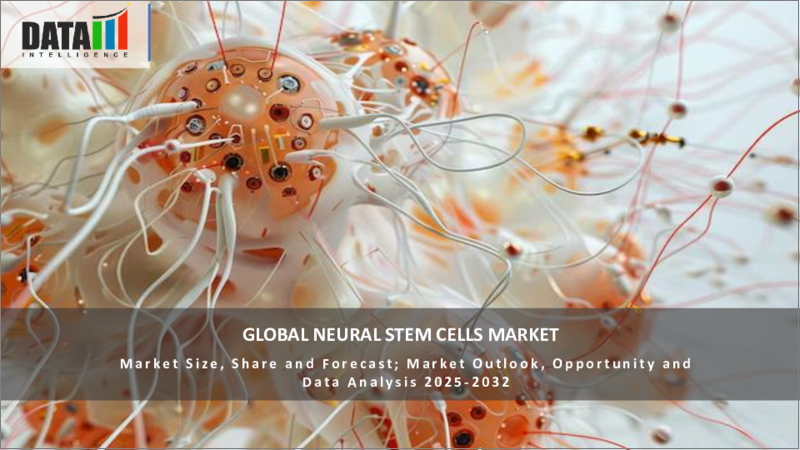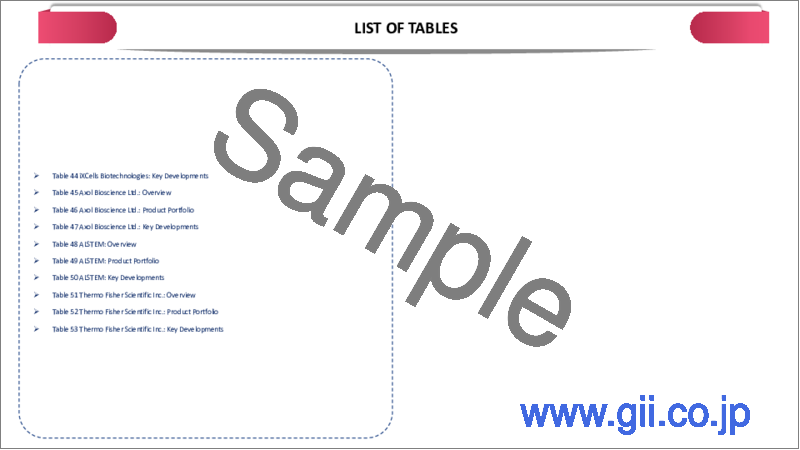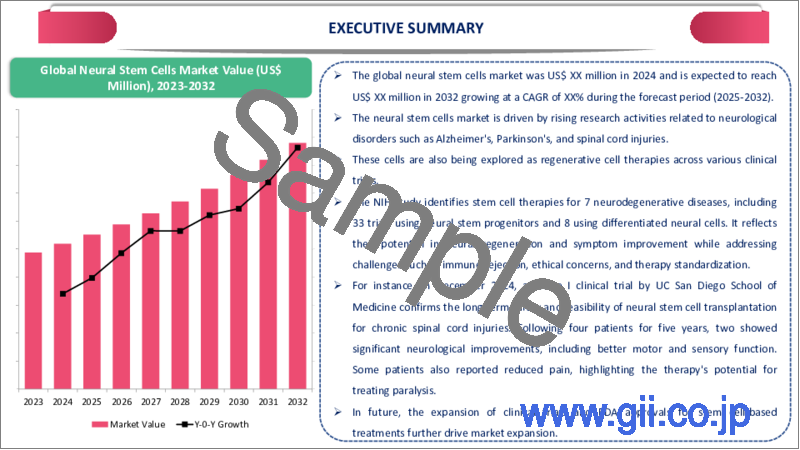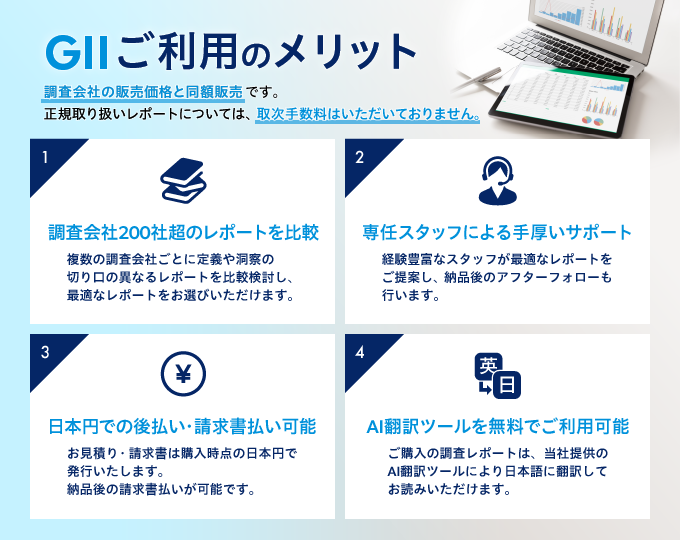|
|
市場調査レポート
商品コード
1606494
神経幹細胞の世界市場-2024~2031年Global Neural Stem Cells Market - 2024-2031 |
||||||
カスタマイズ可能
適宜更新あり
|
|||||||
| 神経幹細胞の世界市場-2024~2031年 |
|
出版日: 2024年12月04日
発行: DataM Intelligence
ページ情報: 英文 195 Pages
納期: 即日から翌営業日
|
- 全表示
- 概要
- 目次
概要
神経幹細胞の世界市場は、2023年に4億3,136万米ドルに達し、2031年には9億4,824万米ドルに達すると予測され、予測期間2024~2031年のCAGRは10.4%で成長する見込みです。
神経幹細胞は、自己複製、増殖、分化が可能な特殊な幹細胞であり、神経系に見られる主要タイプの細胞に分化します。ニューロン(信号伝達を担う神経細胞)、アストロサイト(恒常性を維持し、代謝をサポートするグリア細胞)、オリゴデンドロサイト(軸索を絶縁するミエリンを産生するグリア細胞)などが含まれます。神経幹細胞は、中枢神経系の脳の発達、維持、修復において重要な役割を果たしています。
神経幹細胞市場は、再生医療の進歩、幹細胞研究への投資の増加、神経疾患の治療への応用の高まりにより、力強い成長を遂げています。神経幹細胞は、脳損傷、パーキンソン病やアルツハイマー病などの神経変性疾患、脊髄損傷の治療を目的とした研究や臨床検査において極めて重要です。例えば、NIHの研究では、神経幹前駆細胞を利用した33の臨床検査と、分化した神経細胞を利用した8つの臨床検査を含む、7つの神経変性疾患に対する細胞治療一覧を提示し、その結果と課題について論じています。最後に、治療の有効性を立証するために、標準化された疾患評価尺度に照らして長期的な転帰を測定しています。
市場力学:
促進要因と抑制要因
神経疾患の有病率の上昇
神経疾患の有病率の上昇は、神経幹細胞市場の成長を大きく後押ししており、予測期間中も市場を牽引していくと予想されます。高齢化が進み、アルツハイマー病、パーキンソン病、多発性硬化症などの神経変性疾患を患う人が増加しているため、神経幹細胞別のような革新的な治療ソリューションに対する需要が高まっています。
世界人口の高齢化に伴い、加齢に関連する神経疾患の発症率が上昇しています。例えば、アルツハイマー病協会によると、約700万人のアメリカ人がアルツハイマー病を患っています。2050年までには、この数は1,300万人近くにまで増加すると予測されています。このため、損傷した脳組織の修復や再生を目的とした、神経幹細胞別の治療法を含む再生療法の調査に拍車がかかっています。
パーキンソン病も増加傾向にあり、2022年のパーキンソン病財団の調査によると、米国では毎年9万人近くがパーキンソン病と診断されています。病気の進行を遅らせたり、失われた運動機能を回復させたりする効果的な治療法の必要性が、変性した神経細胞を置き換える能力を研究されている神経幹細胞の市場を牽引しています。
神経幹細胞製品の高コスト
神経幹細胞製品に関連する高コストは、いくつかの点で神経幹細胞市場の成長を大きく妨げています。これらのコストは、複雑な製造プロセス、規制上のハードル、専門的なインフラや専門知識の必要性など、複合的な要因によってもたらされています。
神経幹細胞の分離、培養、拡大のプロセスは複雑で、高い精度が要求されます。高品質の神経幹細胞を生産するには、高価なバイオリアクター、特定の成長因子、厳格な無菌条件が必要です。幹細胞自動培養システムのような先進的設備が必要なため、コストも高くなります。例えば、iXCells BIoTechnologiesのヒト神経幹細胞(iPSC由来、ALS)は1,078米ドル、STEMCELL TechnologiesのヒトIPSC由来神経前駆細胞は995米ドルです。
目次
第1章 調査手法と調査範囲
第2章 定義と概要
第3章 エグゼクティブサマリー
第4章 市場力学
- 影響要因
- 促進要因
- 神経疾患の罹患率の上昇
- 幹細胞と神経科学研究の進歩
- 抑制要因
- 神経幹細胞製品に関連する高コスト
- 機会
- 影響分析
- 促進要因
第5章 産業分析
- ポーターのファイブフォース分析
- サプライチェーン分析
- 価格分析
- 特許分析
- 規制分析
- SWOT分析
- アンメットニーズ
第6章 タイプ別
- ヒト神経幹細胞
- 動物由来の神経幹細胞
- 胚性幹細胞
- 誘導多能性幹細胞
第7章 用途別
- アルツハイマー病
- パーキンソン病
- 多発性硬化症
- 外傷性脳損傷
- 統合失調症
- てんかん
- その他
第8章 エンドユーザー別
- 病院とクリニック
- 研究機関と学術センター
- 製薬・バイオテクノロジー企業
- その他
第9章 地域別
- 北米
- 米国
- カナダ
- メキシコ
- 欧州
- ドイツ
- 英国
- フランス
- スペイン
- イタリア
- その他の欧州
- 南米
- ブラジル
- アルゼンチン
- その他の南米
- アジア太平洋
- 中国
- インド
- 日本
- 韓国
- その他のアジア太平洋
- 中東・アフリカ
第10章 競合情勢
- 競合シナリオ
- 市況・シェア分析
- M&A分析
第11章 企業プロファイル
- Athersys, Inc.
- Thermo Fisher Scientific Inc.
- STEMCELL Technologies
- Merck KGaA
- Axol Bioscience Ltd.
- iXCells BIoTechnologies
- ALSTEM
- Bio-Rad Laboratories, Inc.
- Alomone Labs
- Lifeline Cell Technology
第12章 付録
Overview
The global neural stem cells market reached US$ 431.36 million in 2023 and is expected to reach US$ 948.24 million by 2031, growing at a CAGR of 10.4% during the forecast period 2024-2031.
Neural stem cells are a specialized type of stem cell capable of self-renewal, proliferation and differentiation into the main types of cells found in the nervous system. These include neurons (nerve cells responsible for transmitting signals), astrocytes (supportive glial cells that maintain homeostasis and provide metabolic support) and oligodendrocytes (glial cells that produce myelin to insulate axons). Neural stem cells play a critical role in brain development, maintenance and repair of the central nervous system.
The neural stem cells market is experiencing robust growth, driven by advancements in regenerative medicine, increased investments in stem cell research and rising applications for treating neurological disorders. Neural stem cells are pivotal in research and clinical trials aimed at treating brain injuries, neurodegenerative diseases like Parkinson's and Alzheimer's and spinal cord injuries. For instance, the NIH study presents the list of cellular therapies for 7 neurodegenerative diseases including 33 trials that utilized neural stem progenitors and 8 that utilized differentiated neural cells, discussing the outcomes and challenges. Finally, trials were measured against standardized disease rating scales with long-term outcomes measured to establish the effectiveness of the treatment.
Market Dynamics: Drivers & Restraints
Rising prevalence of neurological disorders
The rising prevalence of neurological disorders is significantly driving the growth of the neural stem cells market and are expected to drive the market over the forecast period. With an aging population and an increasing number of individuals suffering from neurodegenerative diseases, such as Alzheimer's, Parkinson's and multiple sclerosis, the demand for innovative treatment solutions, like those based on neural stem cells, is growing.
As the global population ages, the incidence of age-related neurological disorders is rising. For instance, according to the Alzheimer's Association, nearly 7 million Americans are living with Alzheimer's. By 2050, this number is projected to rise to nearly 13 million. This has spurred research into regenerative therapies, including neural stem cells based treatments that aim to repair or regenerate damaged brain tissue.
Parkinson's disease is also on the rise, a 2022 Parkinson's Foundation-backed study reveals that nearly 90,000 people are diagnosed with Parkinson's disease every year in the U.S. This represents a steep 50% increase from the previously estimated rate of 60,000 diagnoses annually. The need for effective treatments to slow disease progression or restore lost motor function is driving the market for neural stem cells, which are being studied for their ability to replace degenerated neurons.
High cost associated with neural stem cell products
The high cost associated with neural stem cell products is significantly hampering the growth of the neural stem cells market in several ways. These costs are driven by a combination of factors, including complex manufacturing processes, regulatory hurdles and the need for specialized infrastructure and expertise.
The process of isolating, culturing and expanding neural stem cells is complex and requires high levels of precision. Producing high-quality neural stem cells involves expensive bioreactors, specific growth factors and strict sterile conditions. The need for sophisticated equipment, such as automated stem cell culturing systems, increases costs. For instance, iXCells Biotechnologies' human neural stem cells (iPSC-derived, ALS) cost $1,078.00 and STEMCELL Technologies' human IPSC-derived neural progenitor cells cost $995.00.
Segment Analysis
The global neural stem cells market is segmented based on type, application, end-user and region.
Application:
The Parkinson's disease segment is expected to dominate the global neural stem cells market share
The Parkinson's disease segment holds a major portion of the neural stem cells market share and is expected to continue to hold a significant portion of the market share over the forecast period due to the high unmet medical need for effective treatments and the promising potential of neural stem cells to address this challenge.
The National Institute of Health has estimated that the number of people with PD over the age of 50 years is expected to reach around 9 million by 2030, a doubling since 2005, rising to over 12 million by 2040. Parkinson's disease, a progressive neurodegenerative disorder characterized by the loss of dopamine-producing neurons in the brain, affects millions of people globally. The demand for innovative therapies, particularly stem cell-based treatments, has driven the substantial focus on Parkinson's disease within the neural stem cells market.
Current treatments for Parkinson's disease, such as levodopa and dopamine agonists, mainly focus on alleviating symptoms rather than addressing the underlying cause of the disease. These therapies become less effective over time and long-term use can cause serious side effects, such as dyskinesia. The limitations of current treatments have created a significant demand for disease-modifying therapies that could slow, halt, or reverse the damage to neurons. Neural stem cells offer a promising avenue to regenerate lost dopamine-producing neurons, making them highly sought after for PD treatment
North America is expected to hold a significant position in the global neural stem cells market
North America region is expected to hold the largest share in the global neural stem cells market over the forecast period. North America, particularly the United States has long been a global leader in stem cell research. Major academic institutions such as Harvard University, Neural Stem Cell Institute, Stanford University and Johns Hopkins University are at the forefront of stem cell and neuroscience research, including the development of neural stem cell therapies. These institutions advance neural stem cell research.
For instance, the Neural Stem Cell Institute (NSCI) is dedicated to developing regenerative stem cell therapies for diseases of the central nervous system (CNS). The institute's scientists are developing new antibody therapies to remove aggregated proteins due to tauopathies like Alzheimer's Disease, FTD, PSP and CTE, Parkinson's Disease and Huntington's Disease.
The presence of leading biotech companies, such as StemCells Inc., Aspen Neuroscience, Inc., Neuralstem and Mesoblast, contributes to innovation and the translation of research into clinical applications. These companies are working on neural stem cell-based therapies for various neurological conditions, including Parkinson's disease and spinal cord injuries.
For instance, in April 2024, Aspen Neuroscience, Inc. said that the first patient has been dosed in the ASPIRO trial, a Phase 1/2a open-label clinical trial to assess the safety and tolerability of ANPD001, an autologous, dopaminergic neuron cell replacement therapy for participants with moderate to severe Parkinson's disease (PD).
Asia Pacific is growing at the fastest pace in the neural stem cells market
The Asia Pacific region is experiencing the fastest growth in the neural stem cells market. Countries like China and India are facing growing healthcare challenges due to aging populations and higher rates of chronic diseases, driving the need for innovative treatments like neural stem cells to manage or cure these conditions.
Many Asia Pacific countries are rapidly advancing their stem cell research infrastructure, with China, Japan and South Korea emerging as key hubs for stem cell research and development. For instance, China has become one of the top countries for stem cell research and clinical trials, with the Chinese Stem Cell Society actively fostering the growth of regenerative medicine. The Chinese government has committed significant funding to stem cell research, providing opportunities for breakthroughs in neural stem cell applications.
Additionally, in Japan, the government has introduced policies to accelerate regenerative medicine. Japan's Regenerative Medicine Promotion Law, passed in 2014, created a faster pathway for the clinical use of stem cell-based therapies, making it one of the most progressive markets in the Asia-Pacific region for stem cell innovations.
Competitive Landscape
The major global players in the neural stem cells market include Athersys, Inc., Thermo Fisher Scientific Inc., STEMCELL Technologies, Merck KGaA, Axol Bioscience Ltd., iXCells Biotechnologies, ALSTEM, Bio-Rad Laboratories, Inc., Alomone Labs, Lifeline Cell Technology and among others.
Why Purchase the Report?
- To visualize the global neural stem cells market segmentation based on type, application, end-user and region and understand key commercial assets and players.
- Identify commercial opportunities by analyzing trends and co-development.
- Excel data sheet with numerous data points of the neural stem cells market with all segments.
- PDF report consists of a comprehensive analysis after exhaustive qualitative interviews and an in-depth study.
- Product mapping is available in excel consisting of key products of all the major players.
The global neural stem cells market report would provide approximately 70 tables, 78 figures and 195 pages.
Target Audience 2023
- Manufacturers/ Buyers
- Industry Investors/Investment Bankers
- Research Professionals
- Emerging Companies
Table of Contents
1. Methodology and Scope
- 1.1. Research Methodology
- 1.2. Research Objective and Scope of the Report
2. Definition and Overview
3. Executive Summary
- 3.1. Snippet by Type
- 3.2. Snippet by Application
- 3.3. Snippet by End-User
- 3.4. Snippet by Region
4. Dynamics
- 4.1. Impacting Factors
- 4.1.1. Drivers
- 4.1.1.1. Rising Prevalence of Neurological Disorders
- 4.1.1.2. Advancements in Stem Cell and Neuroscience Research
- 4.1.2. Restraints
- 4.1.2.1. High Cost Associated with Neural Stem Cell Products
- 4.1.3. Opportunity
- 4.1.4. Impact Analysis
- 4.1.1. Drivers
5. Industry Analysis
- 5.1. Porter's Five Force Analysis
- 5.2. Supply Chain Analysis
- 5.3. Pricing Analysis
- 5.4. Patent Analysis
- 5.5. Regulatory Analysis
- 5.6. SWOT Analysis
- 5.7. Unmet Needs
6. By Type
- 6.1. Introduction
- 6.1.1. Market Size Analysis and Y-o-Y Growth Analysis (%), By Type
- 6.1.2. Market Attractiveness Index, By Type
- 6.2. Human Neural Stem Cells*
- 6.2.1. Introduction
- 6.2.2. Market Size Analysis and Y-o-Y Growth Analysis (%)
- 6.3. Animal Derived Neural Stem Cells
- 6.4. Embryonic Stem Cells
- 6.5. Induced Pluripotent Stem Cells
7. By Application
- 7.1. Introduction
- 7.1.1. Market Size Analysis and Y-o-Y Growth Analysis (%), By Application
- 7.1.2. Market Attractiveness Index, By Application
- 7.2. Alzheimer's Disease*
- 7.2.1. Introduction
- 7.2.2. Market Size Analysis and Y-o-Y Growth Analysis (%)
- 7.3. Parkinson's Disease
- 7.4. Multiple Sclerosis
- 7.5. Traumatic Brain Injury
- 7.6. Schizophrenia
- 7.7. Epilepsy
- 7.8. Others
8. By End-User
- 8.1. Introduction
- 8.1.1. Market Size Analysis and Y-o-Y Growth Analysis (%), By End-User
- 8.1.2. Market Attractiveness Index, By End-User
- 8.2. Hospitals and Clinics*
- 8.2.1. Introduction
- 8.2.2. Market Size Analysis and Y-o-Y Growth Analysis (%)
- 8.3. Research Institutions and Academic Centers
- 8.4. Pharmaceutical and Biotech Companies
- 8.5. Others
9. By Region
- 9.1. Introduction
- 9.1.1. Market Size Analysis and Y-o-Y Growth Analysis (%), By Region
- 9.1.2. Market Attractiveness Index, By Region
- 9.2. North America
- 9.2.1. Introduction
- 9.2.2. Key Region-Specific Dynamics
- 9.2.3. Market Size Analysis and Y-o-Y Growth Analysis (%), By Type
- 9.2.4. Market Size Analysis and Y-o-Y Growth Analysis (%), By Application
- 9.2.5. Market Size Analysis and Y-o-Y Growth Analysis (%), By End-User
- 9.2.6. Market Size Analysis and Y-o-Y Growth Analysis (%), By Country
- 9.2.6.1. U.S.
- 9.2.6.2. Canada
- 9.2.6.3. Mexico
- 9.3. Europe
- 9.3.1. Introduction
- 9.3.2. Key Region-Specific Dynamics
- 9.3.3. Market Size Analysis and Y-o-Y Growth Analysis (%), By Type
- 9.3.4. Market Size Analysis and Y-o-Y Growth Analysis (%), By Application
- 9.3.5. Market Size Analysis and Y-o-Y Growth Analysis (%), By End-User
- 9.3.6. Market Size Analysis and Y-o-Y Growth Analysis (%), By Country
- 9.3.6.1. Germany
- 9.3.6.2. U.K.
- 9.3.6.3. France
- 9.3.6.4. Spain
- 9.3.6.5. Italy
- 9.3.6.6. Rest of Europe
- 9.4. South America
- 9.4.1. Introduction
- 9.4.2. Key Region-Specific Dynamics
- 9.4.3. Market Size Analysis and Y-o-Y Growth Analysis (%), By Type
- 9.4.4. Market Size Analysis and Y-o-Y Growth Analysis (%), By Application
- 9.4.5. Market Size Analysis and Y-o-Y Growth Analysis (%), By End-User
- 9.4.6. Market Size Analysis and Y-o-Y Growth Analysis (%), By Country
- 9.4.6.1. Brazil
- 9.4.6.2. Argentina
- 9.4.6.3. Rest of South America
- 9.5. Asia-Pacific
- 9.5.1. Introduction
- 9.5.2. Key Region-Specific Dynamics
- 9.5.3. Market Size Analysis and Y-o-Y Growth Analysis (%), By Type
- 9.5.4. Market Size Analysis and Y-o-Y Growth Analysis (%), By Application
- 9.5.5. Market Size Analysis and Y-o-Y Growth Analysis (%), By End-User
- 9.5.6. Market Size Analysis and Y-o-Y Growth Analysis (%), By Country
- 9.5.6.1. China
- 9.5.6.2. India
- 9.5.6.3. Japan
- 9.5.6.4. South Korea
- 9.5.6.5. Rest of Asia-Pacific
- 9.6. Middle East and Africa
- 9.6.1. Introduction
- 9.6.2. Key Region-Specific Dynamics
- 9.6.3. Market Size Analysis and Y-o-Y Growth Analysis (%), By Type
- 9.6.4. Market Size Analysis and Y-o-Y Growth Analysis (%), By Application
- 9.6.5. Market Size Analysis and Y-o-Y Growth Analysis (%), By End-User
10. Competitive Landscape
- 10.1. Competitive Scenario
- 10.2. Market Positioning/Share Analysis
- 10.3. Mergers and Acquisitions Analysis
11. Company Profiles
- 11.1. Athersys, Inc.*
- 11.1.1. Company Overview
- 11.1.2. Product Portfolio and Description
- 11.1.3. Financial Overview
- 11.1.4. Key Developments
- 11.2. Thermo Fisher Scientific Inc.
- 11.3. STEMCELL Technologies
- 11.4. Merck KGaA
- 11.5. Axol Bioscience Ltd.
- 11.6. iXCells Biotechnologies
- 11.7. ALSTEM
- 11.8. Bio-Rad Laboratories, Inc.
- 11.9. Alomone Labs
- 11.10. Lifeline Cell Technology
LIST NOT EXHAUSTIVE
12. Appendix
- 12.1. About Us and Services
- 12.2. Contact Us





